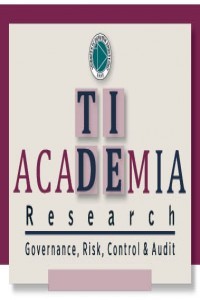USING BIG DATA IN INTERNAL FRAUD DETECTION
USING BIG DATA IN INTERNAL FRAUD DETECTION
internal fraud, fraud detection, big data,
___
- Association of Certified Fraud Examiners (ACFE), Institute of Internal Auditors, & American Institute of Certified Public Accountants. (2008). Managing the Business Risk of Fraud: A Practical Guide. Association of Certified Fraud Examiners.
- Association of Certified Fraud Examiners (ACFE). (2020) Report to the Nations: 2020 Global Study on Occupational Fraud and Abuse. Retrieved from https://www.acfe.com/report-to-the-nations/2020/
- Association of Government Accountants (AGA). (n.d.). The Fraud Triangle. Retrieved from https://www.agacgfm.org/Intergov/Fraud-Prevention/Fraud-Awareness-Mitigation/Fraud-Triangle.aspx
- Babuşcu, S., Hazar, A., & Iskender, A. (2018). Banka Risk Yönetimi: Basel I - II - III - IV Düzenlemeleri. Bankacılık Akademisi Yayınları.
- Baesens, B., Vlasselaer, V., & Verbeke, W. (2015). Fraud Analytics Using Descriptive, Predictive, and Social Network Techniques: A Guide to Data Science for Fraud Detection. Wiley Publishing.
- Baesens, B., Höppner, S., & Verdonck, T. (2021). Data Engineering for Fraud Detection, Decision Support Systems, 113492.
- Becker, R., Volinsky, C., & Wilks, A. (2010). Fraud Detection in Telecommunications: History and Lessons Learned. Technometrics. 52(1), 20-33.
- Bolton, R. & Hand, D. (2002). Statistical Fraud Detection: A Review, Statistical Science. 17(3), 235-255.
- Cressey, D. R. (1953). Other People's Money: A Study in the Social Psychology of Embezzlement. Free Press.
- Fawcett, T. & Provost, F. (1997). Adaptive Fraud Detection, Data Mining and Knowledge Discovery, 1(3), 291-316.
- Ge, D., Gu, J., Chang, S., & Cai, J. (2020). Credit Card Fraud Detection Using Lightgbm Model, International Conference on E-Commerce and Internet Technology, 232-236.
- International Association of Insurance Supervisors (IAIS). (2011, September 28). Application Paper on Deterring, Preventing, Detecting, Reporting and Remedying Fraud in Insurance. Retrieved from https://iaisweb.org/file/34108/application-paper-on-fraud-in-insurance
- Kolodiziev, O., Mints, A., Sidelov, P., Pleskun, I., & Lozynska, O. (2020). Automatic Machine Learning Algorithms for Fraud Detection in Digital Payment Systems. Eastern-European Journal of Enterprise Technologies, 5(107), 14–26.
- Rosset, S., Murad, U., Neumann, E., Idan, Y, & Pinkas, G. (1999). Discovery of Fraud Rules for Telecommunications - Challenges and Solutions, Proceedings of the Fifth ACM SIGKDD International Conference on Knowledge Discovery and Data Mining, NY: ACM Press, 409-413.
- Shirgave, S. K., Awati, C. J., More, R., & Patil, S. S. (2019). A Review on Credit Card Fraud Detection Using Machine Learning, International Journal of Scientific and Technology Research, 8(10), 1217-1220.
- Soviany, C. (2018). The Benefits of Using Artificial Intelligence in Payment Fraud Detection: A Case Study, Journal of Payments Strategy and Systems, 12(2), 102-110.
- The Institute of Internal Auditors (IIA), (2017, January 1). International Standards for the Professional Practice of Internal Auditing (Standards). Retrieved from https://na.theiia.org/standards-guidance/mandatory-guidance/Pages/Standards.aspx
- The Institute of Internal Auditors (IIA), (2019, January). Fraud and Internal Audit: Assurance Over Fraud Controls Fundamental to Success. Retrieved from https://na.theiia.org/about-ia/PublicDocuments/Fraud-and-Internal-Audit.pdf
- Wei, Y., Qi, Y., Ma Q., Liu Z., Shen C., & Fang C. (2020). Fraud Detection by Machine Learning, 2nd International Conference on Machine Learning, Big Data and Business Intelligence, 101-115.
- Wolfe, D. & Hermanson, D. (2004). The Fraud Diamond: Considering the Four Elements of Fraud. The CPA Journal 74.12, 38-42.
- ISSN: 2667-5412
- Başlangıç: 2019
- Yayıncı: Türkiye İç Denetim Enstitüsü
THE EXTERNAL FINANCIAL STATEMENT AUDIT PROCESS AND BLOCKCHAIN TECHNOLOGY
TÜRK BANKACILIK SEKTÖRÜNÜN İÇ SİSTEMLERİNE ELEŞTİREL BİR YAKLAŞIM
Yağızcan Yücel ÇENDİK, Duygu ANIL KESKİN
MUHASEBE VE DENETİMDE MESLEKİ YARGININ EPİSTEMOLOJİK BOYUTU: ÖZNE-NESNE İLİŞKİSİ
COVID-19 KRİZİNDE SÜRDÜREBİLİRLİK PERFORMANSI VE ANORMAL PAY GETİRİSİ
